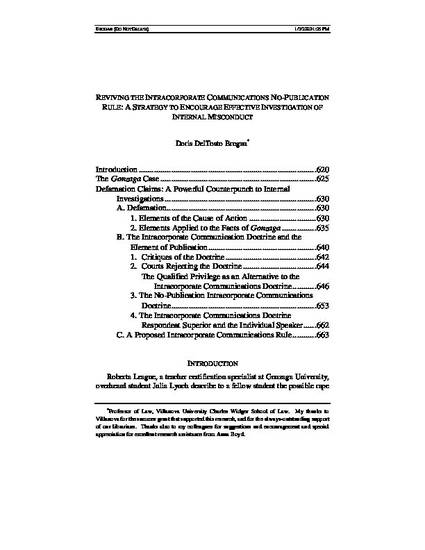
Article
Reviving the Intracorporate Communications No-Publication Rule: A Strategy to Encourage Effective Investigation of Internal Misconduct
Baylor Law Review
(2019)
Abstract
Institutions of all sorts, from schools, to corporations to non-profits are being required to engage in programs designed not only to detect, correct and self-report violations and misconduct, but also to proactively prevent misconduct. Perhaps most compelling are matters involving rape and sexual misconduct, especially in schools and universities. But the issues arise whenever entities seek to prevent or uncover misconduct—misconduct that can range from financial frauds, to environmental crimes, to violation of consumer rights. To meet these obligations the entities need the individuals who think, know and act on the entity’s behalf, to be able to communicate freely and candidly about what is going on; to investigate credible reports; to assess the situation and to formulate responses. And, as important, the entities need those individuals (employees, members, students and others within the organization) who have information to come forward and report what they know freely, openly and without fear of retaliation. Increasingly, however, defamation actions are becoming a powerful counterpunch to entities and individuals taking on misconduct. Employees terminated for wrongdoing, and students charged with sexual or other misconduct are not only suing for reinstatement, but are also bringing claims for defamation. The mere threat of a defamation suit and the expense and disruption it will bring can cause the entity, and the individuals within, to hesitate, undermining the goal of encouraging proactive response to internal wrongdoing.
One way to combat the chilling effect of these defamation suits is to adopt a robust intracorporate communications doctrine. The intracorporate communications doctrine provides an absolute defense to a defamation claim. It is a legal fiction, operating on the publication element of defamation by deeming communications among members of the entity, under the appropriate circumstances, simply not communicated—not published.
This article will use Doe v. Gonzaga University, a defamation case based on a report of sexual assault by one student on another, to analyze the issues raised by the intracorporate communications doctrine and to propose an approach.
Using the Gonzaga case as an example, I set up the motivation for protecting internal communications through an intracorporate communications doctrine. I take the position that courts should recognize a carefully circumscribed and clearly articulated intracorporate communications doctrine in defamation cases.
First, I argue that courts must disentangle the question of whether a statement is “published” for defamation purposes (the issue addressed by the intracorporate communications doctrine) from the question of whether a particular statement should be partially protected by a qualified privilege. This distinction has become blurred by many courts. But clarity is essential for organizations attempting to behave responsibly regarding potential misconduct within the organization.
I set the stage for how the intracorporate communication doctrine operates by setting out the elements of the cause of action for defamation, applying them to the facts of the Gonzaga case.
Next, I explore how the intracorporate communications doctrine developed, identifying aspects of its history and pedigree that contribute to confusion about the doctrine, and confusion about how, when and in fact whether it should apply. In this section I examine the criticisms of commentators and the reasons offered by courts rejecting the doctrine. Typically, these courts find the intracorporate communications doctrine’s virtual immunization of arguably false and defamatory speech as unnecessary, preferring to apply a qualified privilege. I respond to this by demonstrating that the qualified privilege does not provide sufficient protection to foster the candid, forthcoming communications necessary to combat wrongdoing within entities.
Then, I examine those courts that have applied the doctrine and their reasoning for doing so. I also explore the confusion in how courts have applied it and the difficulty of untangling the intracorporate communications doctrine from the qualified privilege, and from the doctrine of respondeat superior.
Finally, I take the position that a clearly defined, appropriately limited intracorporate communications doctrine should be adopted if we are to take seriously preventing and policing wrongdoing within organizations. I propose a model for such a doctrine and apply it to the Gonzaga facts to demonstrate how such a doctrine would work to encourage those who know about wrong doing within entities to speak up and to do so to the appropriate individuals.
Keywords
- Intracorporate communications,
- Internal Misconduct
Disciplines
Publication Date
Spring May 1, 2019
DOI
2019
Citation Information
Doris DelTosto Brogan. "Reviving the Intracorporate Communications No-Publication Rule: A Strategy to Encourage Effective Investigation of Internal Misconduct" Baylor Law Review Vol. 71 Iss. 3 (2019) p. 620 Available at: http://works.bepress.com/doris_deltosto_brogan/12/
